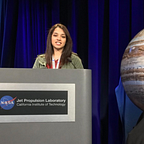Moons of the Solar System: Ganymede
Jupiter’s Ganymede is the biggest moon in our solar system, even bigger than Mercury
Ganymede is one of the largest bodies in our solar system, naturally orbiting the other large body, Jupiter. It was discovered by Galileo when he perfected the design of the telescope and pointed it at Jupiter in 1610. It is made of rock and water ice, and has an underground ocean that contains more water than all of earth’s oceans. In fact, it might contain the most water in the solar system.
The moon was formed along with Jupiter.
Ganymede is a differentiated body. This means that it has a discernable core and mantle/crust, much like planets do. Ganymede’s core is liquid iron, like earth’s. It is tidally locked to Jupiter, which means that the same side of the moon faces the planet, again like our earth. Ganymede also has its own magnetic field and atmosphere.
Its surface is covered with bands causing a distinct color variation between two kinds of areas: the older, darker regions, and the younger, striated, brighter regions. The striated regions pose a mystery because they can only be formed by ice on the surface melting in patterns, and we haven’t been able to figure out how.
There is a planned mission to Ganymede in 2020. The JUpiter ICy moon Explorer (JUICE) is going to fly close to four of Jupiter’s biggest moons before settling into orbit around Ganymede. There might be an accompanying Russian lander as well looking for signs of life in the subsurface ocean.
